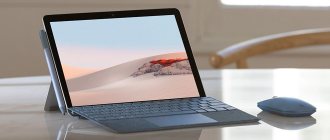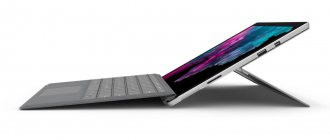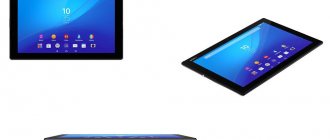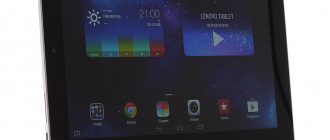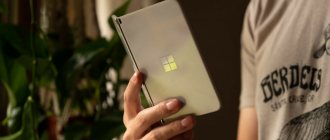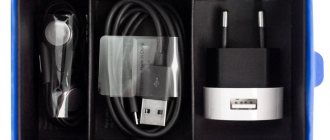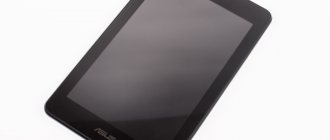This year, Microsoft continued to expand its line of laptops with the introduction of the Surface Laptop. Moreover, while the company’s other devices are transformers, the new product has a traditional form factor for laptops. Microsoft is positioning the Surface Laptop as a laptop for schoolchildren and students, as well as for those users who need a laptop for office work. Let's take a look at what features the device offers and whether it's worth considering purchasing.
Microsoft Surface Laptop (D9P-00001) Notebooks, ultrabooks on
Notify when on sale
Contents of delivery
The Surface Laptop's equipment is minimal; in the box with the laptop you can only find a charger with a detachable cable.
But at least the charging block is not entirely simple; it has a built-in USB connector, which allows you to directly connect other devices to it for charging.
Interfaces
The thin, compact bodies of both gadgets did not allow the laptops to be equipped with a more or less decent set of interfaces.
Surface Laptop 2 can only boast one measly USB-A, a mini-jack and a miniDP connector for outputting video to an external monitor: no Thunderbolt 3 for you, no USB-C.
But the MacBook Air is equipped with two Thunderbolt 3 ports (USB-C connector), although one of them will often be used for charging. But you can connect an external video card to it and turn your workhorse into a gaming machine.
Winner : MacBook Air
Design and materials
Surface Laptop can be called without understatement one of the most stylish laptops on the market.
The model has a minimalist design with straight lines of the body, which are only slightly rounded at the corners, but at the same time form sharp beveled edges.
The display is covered with protective glass, and its lid and lower part of the Surface Laptop are made of dense aluminum, and the area around the keyboard and between the keys themselves is covered with faux suede - Alcantara.
This material is patented and produced by the Italian company Alcantara SpA; it is very pleasant to the touch and relatively durable. Based on my experience of using an Alcantara case for the Galaxy S8, I can note that if you don’t set yourself the task of staining the fabric and rendering it unusable, then doing this during normal use is not so easy. Alcantara has a rough, but at the same time dense surface that does not allow moisture to pass through well, and the material itself does not burn. However, it is worth considering that, like any fabric, Alcantara wears out and gets dirty, and although it can be washed and cleaned, it is not very convenient to do this in a laptop.
Overall, the Surface Laptop may not have the most practical body, but it is certainly one of the most stylish. Moreover, Microsoft took care of the colors, there are only four of them, but they all look very nice.
The Surface Laptop body measures 308.1 x 223.27 x 14.48 mm and weighs 1.25 kg.
The laptop turned out to be compact even for a 13-inch model, although it does not have minimal bezels around the screen.
Connectors
In addition to the USB port on the charger block, on the body of the Surface Laptop itself there was only room for a proprietary charging port, one USB 3.0, mini DisplayPort and a 3.5 headphone jack.
As you can see, the set of ports is minimal, and the laptop could use at least one more USB port, as well as USB Type-C.
Surface Headphones
Suddenly for everyone, Microsoft introduced wireless headphones with active noise reduction and the Cortana voice assistant on board.
One battery charge is enough for 15 hours of operation with active noise cancellation turned on. In this case, a full charge from the USB Type-C port occurs in two hours. Very decent numbers, I think.
Surface Headphones have intuitive touch controls. But I especially liked the ring built into the earphone that regulates the level of noise reduction. Straight fire:
The headphones weigh 290 grams. Microsoft says they're very lightweight and breathable, meaning they can be worn all day without issue.
The range of reproduced frequencies is standard: from 20 Hz to 20 kHz. Sound pressure up to 115 dB.
The headphones will be on sale before the end of the year. They will cost $349. Do you think they can compete with Sony and Bose?
Display
The laptop's 13.5-inch IPS touch screen with PixelSense technology has a resolution of 2256×1504 pixels and an aspect ratio of 3:2. The latter, considering that you spend most of your time on a laptop in the browser, looks like a good solution, and it’s a pity that not all manufacturers use it.
The display itself provides good viewing angles and color reproduction. Its color gamut is slightly more than 100% sRGB, the temperature is at 6500K, but the gamma curve and backlight are slightly uneven.
The minimum brightness of the Surface Laptop display, according to our measurements, is 9 cd/m2, the maximum is 322 cd/m2, and the contrast is 1526:1.
It's also important to note that the touchscreen on this laptop feels like overkill. Given the form factor, it is not as convenient to use as on the Surface Book and Surface Pro, and if Microsoft decided to remove the touch layer from the display, the Surface Laptop would not lose anything from this.
Platform and performance
We tested a Surface Laptop in the basic configuration with a dual-core Intel Core i5-7200U processor operating at 2.5 GHz (3.1 GHz in Turbo Boost mode), integrated Intel HD Graphics 620, 4 GB of RAM LPDDR3-1866, as well as a 128 GB SSD.
The Surface Laptop's processor is powerful enough to handle most tasks that users of a compact laptop might encounter. At the same time, 4 GB of RAM is enough for comfortable work in the browser with a dozen open sites, with documents or with a simple photo editor.
The performance of the integrated graphics is enough to easily draw an interface or play video in 2K, but if you want to play games, you will have to limit yourself to casual ones.
What I didn’t like about the Surface Laptop hardware platform was the speed of the built-in Toshiba SSD with a capacity of 128 GB. Microsoft used a model that provides good read speeds of 650 MB/s, but not very fast, as for an SSD, write speeds of 130 MB/s.
Heating and stability
The processor in the Surface Laptop has a design thermal package of 15 W, and the laptop itself is equipped with a small fan, the air exhaust and intake holes are located on the rear edge of the case, and its lower part is completely closed.
In the AIDA64 system stability test, at maximum load, the temperature of the processor cores can briefly rise to 80 degrees Celsius, but when the cooling system is turned on, it drops to 55-57 degrees Celsius and remains at this level.
There is no throttling, and the body becomes warm, but this does not cause discomfort. The fan is very quiet, almost inaudible.
Autonomy of Microsoft Surface Laptop 3
The Surface Laptop 3's battery life is far from perfect. I would like to point out that so far I have only had the opportunity to drain the battery twice.
The first time is shortly after the initial setup so that the laptop can configure many things in the background, consuming CPU time. About seven hours after a full charge, I received a message telling me it was time to connect the computer to a power source or save data to apps.
This is a good result, since we are talking about real work, and not about looping video playback or similar measurements, although it is not sensational. The fast charging system pleased me: in about an hour the battery is charged from 5 to 80 percent.
operating system
By default, the Surface Laptop comes with the Windows 10 S operating system. Despite the fact that the letter S in the prefix to a product name often means some kind of improvement, this is not the case in Windows 10 S. On the contrary, the new version of the Microsoft operating system is stripped down. The company conceived it as an OS for not very expensive laptops that could be used by schoolchildren and students. But considering the Surface Laptop's starting price of $999 in the US, Windows 10 S looks very odd on this laptop. After all, it, for example, allows you to install applications only from the Windows Store, does not allow you to change the Edge browser or even the Bing search engine.
Until December 31, 2020, Windows 10 S on Surface Laptop can be upgraded to Windows 10 Pro for free, and in the future the company plans to charge $50 for such an upgrade.
The update process itself is a little confusing; to start it, you need to download and open the exe file of any program, after which the system will inform you that this can be done if you upgrade to a different version of Windows and immediately offer to do this.
The very idea of limiting the installation of programs only to the Windows Store could have the right to life if the Microsoft store had all the popular applications. But the irony is that even Office, at least in Ukraine, is not in the Windows Store.
As a result, Windows 10 S on the Surface Laptop looks like an outright “crutch” that could be tolerated if the laptop was offered at a more affordable price. But in this situation, it is better to immediately take advantage of the opportunity and upgrade to Windows 10 Pro for free. Moreover, the entire process of switching from one OS version to another takes only a few minutes.
Windows Hello
Like other Surface models, Microsoft uses multiple cameras on the Surface Laptop, including infrared, to power Windows Hello facial recognition, which allows you to quickly unlock your laptop.
It is worth noting that this functionality works very well, cameras quickly scan and recognize a face, and you can scan it both with and without glasses, this will only improve the recognition speed. At the same time, the cameras in the Surface Laptop are able to determine volume and cannot be deceived using photography.
Price
MacBook Air costs around 90,000 rubles, almost twice as expensive as the previous model. Surface Laptop 2, depending on the configuration, can cost from 65,000 to 200,000 rubles, but a configuration similar to a MacBook costs about 110,000.
The Microsoft brainchild achieved victory only thanks to a wide selection of configurations and, as a consequence, prices.
Winner : Surface Laptop 2
Surface Laptop 2 price: RUB 64,700
MacBook Air price: RUB 89,400
Keyboard and touchpad
The Surface Laptop uses a backlit chiclet-style keyboard.
The keys are located at a sufficient distance from each other and press with a pleasant stroke. Typing on the laptop keyboard is convenient; it has a standard layout.
The touchpads that Microsoft uses on its Surface models are the best among Windows laptops. The Surface Laptop has a fairly large touchpad, it very accurately determines the positioning of the finger, supports gestures and allows you to comfortably use the laptop without external peripherals.
Keyboard
The updated keyboard has caused a lot of controversy among Apple fans. Some people absolutely don’t like it, others fell in love with it from the very first printed word... If you approach the issue without unnecessary emotions, then you can say that the keyboard has at least not become worse, although it takes a couple of days to get used to.
But the Microsoft Surface Laptop 2 keyboard is a real work of art. Perfect balance, pleasant ride, clear response, excellent tactile sensations thanks to the Alcantara coating. There is nothing better among mobile computers today.
Winner : Surface Laptop 2
Audio
The Realtek High Definition Audio Driver is responsible for sound reproduction in the Surface Laptop; it is enough to listen to music or watch videos with headphones even at medium volume.
Two external speakers are hidden under the keyboard, and it should be noted that they sound surprisingly spacious and loud, which is not what you expect from a thin laptop.
Autonomy
The 45.2 Wh battery built into the Surface Laptop should provide good battery life, at least Microsoft claims 14.5 hours of video playback. In the PCMark 8 Home test under load with a brightness of 200 cd/m2, the laptop lasted 6 hours.
With an average load and with active automatic display brightness adjustment, you can count on 8 hours of operation. This is a good result, because the Surface Laptop provides battery life during a standard workday.
4
ITC.UA rating
Pros: design, nice colors, high-quality display, quiet cooling system, excellent keyboard and touchpad, “clean” Windows, fast Windows Hello, sound quality of external speakers, USB port on the charger, autonomy
Cons: 4 GB of RAM in the base configuration, SSD write speed, one USB port on the case, Windows 10 S
Conclusion: The Surface Laptop is a thin and light laptop with a 13.5-inch display, made in an interesting design in an aluminum case with an Alcantara insert around the keyboard. The model has an excellent display, a comfortable keyboard and touchpad, but not very high performance in the basic version, a not very fast SSD for recording and a high cost, as for such a configuration. Other than that, staying with Windows 10 S doesn't make any sense on such an expensive laptop. Thus, the basic Surface Laptop may appeal to those users who choose a laptop based on design rather than performance. The model really looks great on the desk, but for work tasks in this price category there are more productive solutions. However, it should be noted that older versions of the Surface Laptop are more interesting in terms of configuration and faster in operating speed, but they are also more expensive
Specifications
| Microsoft Surface Laptop (D9P-00001) Notify when available | |
| Type | Laptop |
| Design | Classical |
| operating system | Windows 10 Home |
| Diagonal, inches | 13,5 |
| Matrix type | IPS |
| Coverage type | no data |
| Permission | 2256×1504 |
| Sensory | + |
| CPU | Intel Core i5-7200U |
| Base clock frequency, GHz | 2,5 |
| Maximum clock frequency, GHz | 3,1 |
| Number of processor cores | 2 |
| Chipset | No data |
| RAM, GB | 4 |
| Maximum amount of RAM, GB | 4 |
| Memory type | no data |
| Hard disk, GB | — |
| SSD, GB | 128 |
| Optical drive | — |
| Graphics adapter, memory capacity | Intel HD Graphics 620 |
| External ports | 1x USB 3.0; 1x Mini DisplayPort; 3.5mm headphone jack |
| Card reader | + |
| WEB camera | + |
| Keyboard backlight | + |
| Passive cooling system | — |
| Fingerprint scanner | — |
| Keyboard with number pad | — |
| Network adapter | — |
| WiFi | 802.11ac |
| Bluetooth | 4.1 |
| 3G/LTE | — |
| Weight, kg | 1,25 |
| Size, mm | 308,02×223,20×14,47 |
| Housing material | no data |
| Cap color | grey |
| Case color | grey |
| Capacity, mAh | No data |
| Number of cells | No data |
| Power, Wh | No data |
| Battery voltage, V | No data |
| Battery type | Lithium Polymer |
Surface Pro
Last year, we published a review of the Microsoft Surface Laptop 2 in which we concluded that the device stands out from the general Surface line because it doesn't offer new ways to interact with your computer, but rather demonstrates a new take on design from Microsoft using such materials like metal and Alcantara. While some reviewers have argued that it doesn't make sense for Microsoft to release the next version of the Surface Laptop - it's just a typical Ultrabook, we think the 3:2 aspect ratio display is excellent, the typing and trackpad experience is excellent, and the sound is excellent and overall design made the Surface Laptop an engineering marvel that delivered essential functionality.
In 2020, Microsoft released a larger 15-inch version of the Surface Laptop 3, with a larger screen, longer battery life, and a great opportunity for Microsoft's new partner AMD to show the world how Intel can beat Intel, but still in a more traditional design.
What's new in the Microsoft Surface Laptop 3 15″
Following the development pattern of the Surface Book 2, Microsoft introduced a more powerful and theoretically higher performance version of its 13.5-inch Surface Laptop 3. But compared to the 13.5-inch Surface Laptop 3, which uses next-generation Intel processors, the 15-inch Laptop 3 is built on AMD hardware. The move is likely intended to bring down the cost of the device since AMD offers cheaper solutions than Intel, but some believe that the combination of AMD's Ryzen processor and Vega GPU could outperform a similar configuration from Intel.
In terms of ports, Microsoft has added a new USB Type-C 3.1 Gen 2 (10 GB/s) port to the Surface Laptop 3, in keeping with the Surface line refresh trends. This port is the most powerful Type-C port, which allows you to connect two 4K displays at 60Hz to the laptop. It also supports Power Delivery (PD), so you can use a 65W Type-C charger for fast charging.
Microsoft Surface Laptop 3 15″ Specifications
| Operating system | Windows 10 Home |
| Display | 15-inch PixelSense, 3:2 aspect ratio, 2496×1664 (201 PPI) |
| Processor | AMD Ryzen 5 or Ryzen 7 custom CPU |
| GPU | AMD Vega 9 AMD Vega 11 |
| Memory | 8GB, 16GB, or 32GB LPDDR4 |
| Storage | 128GB, 256GB, 512GB, 1TB SSD (replaceable) |
| Front camera | 720p Dual far-field Studio Mics |
| Security | Windows Hello face authentication camera, Firmware TPM |
| Connectivity | Wi-Fi 5: 802.11ac compatible Bluetooth 5.0 |
| Ports | One USB-C, One USB-A, One Surface Connect, 3.5 mm headphone jack |
| Battery | Up to 11.5 hours |
| Weight | Up to 3.4 lbs (1.54kg) |
| Colors | Platinum metal, Matte Black metal |
In addition to the new USB Type-C port, Surface Laptop 3 has a standard USB Type-A port and a headphone jack, which are located on the left side of the laptop. On the right is the Surface Connect+ port, which now supports fast charging from 0 to 80 percent within an hour. Microsoft has included a standard 65-watt charger in the package. This is the same charger that powers the Surface Pro 7 or Surface Laptop 3 13.5-inch.
The Surface Laptop 3's front camera is very good, even with the previous 720p resolution. It sits between two long-range microphones that work well and greatly enhance the Skype experience.
For Wi-Fi and Bluetooth connectivity, Microsoft uses a Qualcomm Atheros QCA61x4 chip. It's an odd choice because it's a 2015 chip that doesn't support Wi-Fi 6, unlike the chip in the 13.5-inch Intel-based Surface Laptop 3 laptops. Instead, it supports Wi-Fi 5 and is significantly slower. This is a direct result of the switch to AMD processors.
Photo: iFixit
Also new this year is modular design and increased maintainability. Previously there were problems with this because all Surface Laptops were glued together. This year, you can easily upgrade or replace the SSD and replace the battery by removing the keyboard panel. However, this is not critical for the end user - in any case, you will need to take the Laptop 3 to an authorized service center to perform these operations.
The 15-inch Surface Laptop 3 looks exactly the same as the 13.5-inch model. The screen's 3:2 aspect ratio makes it quite large, but at 1.54kg it's lighter than most 15-inch laptops. While the all-metal design looks great, you have to pay attention. It is susceptible to dents, chips and scratches from seemingly minor impacts. It must be carried in a well-protected bag without any foreign objects.
The 15-inch Surface Laptop 3 model only offers two options: platinum and matte black. Both are amazing. If you don't like fingerprints, platinum is a better choice as it also hides dents and scratches better. If you scratch the matte black model, it will leave a noticeable silver mark.
The 15-inch Laptop 3 doesn't have an Alcantara version, although the 13.5-inch does offer it in two color options. The use of Alcantara is somewhat controversial: some people like its tactile characteristics, while others worry about it getting dirty over time.
The best thing about the Surface Laptop 3 is what's hidden. The speakers are located under the keyboard with no visible grilles and there are no air intakes at the bottom for the cooling system. Instead, the vents are located at the back of the laptop. This design is great because your knees will never block the ventilation. It looks clean and uncluttered, a common feature of the Surface Laptop.
Every little detail on the 15-inch Surface Laptop 3 is well thought out and makes a great impression. Closing the lid is especially special, as it has enough resistance to not slam shut, but to close quietly. You can also easily open the laptop with one hand, despite the lack of a notch like the Apple MacBook Pro.
Display Microsoft Surface Laptop 3 15″
Microsoft Surface Laptop 3 has a 15-inch PixelSense LCD display with a 3:2 aspect ratio and a resolution of 2496x1664 pixels. The density of 201 pixels per inch (PPI) is lower than the Surface Pro 7 (267 PPI) and Surface Book 2 (260 PPI), but it's not very noticeable.
The display bezel is relatively thin, and the screen is protected by Gorilla Glass 3 with an oleophobic coating. Glass covers the entire screen from edge to edge with no plastic or rubber seals on the bezel - another great design detail.
Surface Laptop 3 supports handwriting with the Surface Pen, but the display doesn't open up to 180 degrees and there's no space on the body to attach the pen on the go or when you're not using it. In my opinion, a device in the form factor of a classic laptop is extremely inconvenient for drawing; the display constantly has to be supported with a second hand, however, in a pinch, the stylus is great for signing a document or making a quick note. Surface Dial is also supported, but without display integration.
In terms of color accuracy, the Laptop 3's screen delivers 96% sRGB, 72% AdobeRGB and 75% DCI-P3. These numbers are lower than the Surface Book 2 (99% sRGB and 81% AdobeRGB), which is unfortunate.
Peak brightness set to 100 percent is just under 400 nits, while changing intensity to 0 percent is 3.4 nits.
As we said in our Surface Pro 7 review, Microsoft seems to be falling behind in the display quality race compared to Lenovo, HP and Dell. Features like HDR400 (500+ nits) support and Dolby Vision are now standard features on premium Ultrabooks. Likewise, there's new anti-glare technology that retains the benefits of a glossy display but reduces reflectivity, making the device better for long-term use. The same applies to the use of OLED displays and a faster refresh rate instead of 60Hz.
The 15-inch Surface Laptop 3 (and the new Surface Pro 7) lack all of these technologies. Color accuracy and color gamut are not as good as other premium Ultrabooks. Windows 10 natively supports wide color gamut apps, HDR apps, and games, but the Surface Laptop 3 does not. This is very upsetting.
Microsoft Surface Laptop 3 15″ Keyboard and Trackpad
Microsoft uses the best keyboards and trackpads in its Surface lineup. This fully applies to the Surface Laptop 3 15″, which has received the best in this area. Microsoft has made the keyboard slightly quieter than the Surface Laptop 2's, with key travel still at 1.5mm and a three-stage backlight.
The excellent typing experience is enhanced by ample support for your wrists. Your hands will not hang down when typing, and you can place them comfortably on the body. However, since Microsoft didn't use Alcantara, the metal keyboard may get scratched if you're wearing a watch or bracelet.
The Precision Trackpad is now 20 percent larger than the Surface Laptop 2. It's amazing, although not as huge as the one on the Apple MacBook, it's still plenty big. The click is soft and the accuracy is excellent.
Sound Microsoft Surface Laptop 3 15″
Traditionally, Microsoft computers have the best sound among all laptops. Surface Pro has amazing front-facing speakers that sound better than you'd expect. The same goes for the Surface Book 2.
The sound quality on last year's Surface Laptop 2—even with the speakers hidden under the keyboard—is the best I've heard. It's rich yet clear, and sounds fuller than the Surface Pro or Surface Book thanks to its ability to resonate within the laptop's body.
However, the 15-inch Surface Laptop 3 sounds slightly worse. Volume is excellent, but above the 60 percent threshold there is some slight distortion.
It's not clear if this is simply a software tuning issue, or if it's due to the lack of Alcantara coating. It's possible that Microsoft could tweak the sound in software, but for now the Laptop 3's sound is disappointing.
Microsoft Surface Laptop 3 15″ Performance and Battery
We had high hopes for the combination of AMD Ryzen and Vega chips in the 15-inch Surface Laptop 3. But despite the hype around the "tuned" versions of Vega and Ryzen 7 GPUs, they don't have much to offer.
The easiest way to say it is that the 15-inch Surface Laptop 3 is simply a version of the 13-inch Ultrabook with a slightly slower processor and a slightly more powerful GPU. If you were expecting a significant increase in performance with increasing device diagonal, such as in the Microsoft Surface Book 2 line, then I have to disappoint you.
The 15-inch Surface Book 2 uses a discrete GPU, while the Laptop 3 uses an integrated AMD GPU. This means the graphics won't compare to the Surface Book 2, but overall they'll be better than Intel processors.
It should be noted that in the Surface Laptop 3 line with a diagonal of 15 inches, there is also a version based on the Intel Core i7-1065G7 processor, intended for corporate users - Business Version, unfortunately we have not yet had the opportunity to test it, but we provide data on its performance based on open sources.
Geekbench 5.0 (CPU)
| Device | CPU | Single core | Multi core |
| Surface Laptop 3 15 | Ryzen 7 | 883 | 3,400 |
| Surface Laptop 3 15 | Ryzen 5 | 769 | 2,720 |
| Surface Laptop 3 15 | i7-1065G7 | 1,336 | 4,893 |
| Surface Laptop 3 13.5 | i5-1035G7 | 1,177 | 4,413 |
| Surface Laptop 2 | i5-8250U | 909 | 3,372 |
| Surface Pro 7 | i5-1035G4 | 1,191 | 4,441 |
| Surface Pro 6 | i7-8650U | 1,113 | 3,519 |
| Surface Pro 6 | i5-8250U | 904 | 3,440 |
| Dell XPS 13 2-in-1 7390 | i7-1065G7 | 1,209 | 3,571 |
| Dell XPS 15 7590 | i9-9980HK | 1,176 | 7,624 |
Geekbench 4.0 (CPU)
| Device | CPU | Single core | Multi core |
| Surface Laptop 3 15 | Ryzen-7 | 4,243 | 12,859 |
| Surface Laptop 3 15 | Ryzen-5 | 3,985 | 12,079 |
| Surface Laptop 3 15 | i7-1065G7 | 5,727 | 19,593 |
| Surface Laptop 3 13.5 | i5-1035G7 | 5,265 | 17,345 |
| Surface Laptop 2 | i5-8250U | 4,203 | 13,233 |
| Surface Laptop | i5-7200U | 3,725 | 7,523 |
| Surface Pro 7 | i5-1035G4 | 5,245 | 17,350 |
| Surface Pro 6 | i7-8650U | 5,037 | 13,864 |
| Surface Pro 6 | i5-8250U | 4,287 | 14,031 |
| Surface Pro 5 | i5-7300U | 4,302 | 8,482 |
| Surface Pro 5 | i7-7660U | 4,513 | 9,346 |
| Surface Pro 4 | i5-6300U | 3,319 | 6,950 |
| HP Specter x360 15 | i7-9750H | 4,968 | 18,790 |
| HP Specter x360 15 | i7-8565U | 5,246 | 16,272 |
| Dell XPS 13 2-in-1 7390 | i7-1065G7 | 5,459 | 19,097 |
| Razer Blade Stealth | i7-8565U | 5,139 | 16,339 |
| Dell Latitude 7400 2-in-1 | i7-8665U | 5,469 | 15,800 |
PCMark 10
| Device | Score |
| Surface Laptop 3 15 (AMD) | 4,006 |
| Surface Laptop 3 15 (Intel) | 4,604 |
| Surface Laptop 2 | 2,748 |
| Surface Pro 7 i5 | 3,992 |
| Surface Pro 6 i7 | 3,644 |
| Surface Pro 6 i5 | 3,501 |
| Dell XPS 13 2-in-1 7390 | 4,427 |
| Dell XPS 15 7590 | 5,521 |
| Dell XPS 13 2-in-1 7390 | 4,427 |
| Dell Inspiron 13 7390 2-in-1 | 3,764 |
| HP Pavilion x360 14 | 3,558 |
| Lenovo ThinkBook 13s | 3,468 |
Geekbench 5.0 OpenCL
| Device | GPU | Compute score |
| Surface Laptop 3 15 | Vega 9 | 11,334 |
| Surface Laptop 3 15 | Iris Plus | 10,497 |
| Surface Laptop 3 13.5 | Iris Plus | 9,811 |
| Surface Laptop 2 | Intel UHD 620 | 5,514 |
| Surface Pro 7 | Iris Plus | 7,613 |
| Surface Pro 6 | Intel UHD 620 | 5,396 |
| Dell XPS 13 2-in-1 7390 | Iris Plus | 10,406 |
| HP Specter x360 15 | GTX 1050Ti | 82,576 |
| HP Specter x360 15 | MX150 | 47,284 |
| Dell Precision 3541 | NVIDIA Quadro P620 | 12,469 |
CrystalDiskMark
| Device | Read | Write |
| Surface Laptop 3 15 | 2,028 MB/s | 806 MB/s |
| Surface Laptop 3 13.5 | 2,338 MB/s | 1,583 MB/s |
| Surface Laptop 2 | 1,509 MB/s | 811 MB/s |
| Surface Laptop | 486 MB/s | 244 MB/s |
| Surface Pro 7 | 2,040 MB/s | 809 MB/s |
| Surface Pro 6 | 1,632 MB/s | 814 MB/s |
| Surface Pro 5 | 847MB/s | 801 MB/s |
| Surface Book | 1.018 MB/s | 967 MB/s |
| Dell XPS 13 2-in-1 7390 | 2,400 MB/s | 1,228 MB/s |
| Huawei MateBook X Pro (new) | 3,416 MB/s | 2,779 MB/s |
| HP Specter x360 13t | 3.085 MB/s | 1,182 MB/s |
| LG gram 14 2-in-1 | 558.1 MB/s | 523.1 MB/s |
In terms of processor performance, the Ryzen 7 is comparable to the 8th Gen Intel Core i5-8250U in Geekbench 4 and Geekbench 5 tests. Meanwhile, the 10th Gen Intel Core i5-1035G4 easily outperforms the Ryzen 7.
AMD's integrated graphics are superior to Intel's UHD 620. But they're only marginally faster than the tenth-generation Iris Plus. While you can play games on the Surface Laptop 3, keep in mind that this is not a gaming laptop and most popular first-person shooters will require you to use the lowest settings.
As for battery life, Microsoft claims 11.5 hours using a new test based on 10 browser tabs and Microsoft Office running. That's not too far off from PCMark 10's Modern Office test, which combines Office use, browser, video conferencing, and downtime. My results show that in fact we can talk about 10 hours of battery life, compared to eight hours on the lower-end Surface Pro 7 model.
SSD performance is on par with other Surface devices this year. Read speeds reached 2000 MB/s, compared to 1500 MB for Laptop 2, and 486 MB/s for the first version of Laptop. Write speeds are still below the industry average, at just 800 MB/s.
Source: Windows Central
Source: Windows Central
Finally, the 15-diagonal Surface Laptop 3 barely gets hot under load. The temperature rarely exceeded 33 degrees and the fans were almost silent.
Let's sum it up
The 15-inch Surface Laptop 3 has no obvious advantage over the smaller 13.5-inch model, except for a larger screen, unlike the Surface Book 2, where the 15-inch model had a more powerful GPU and even had support for the Xbox Wireless Controller.
Microsoft claims that the Surface Laptop 3 is the fastest 15-inch ultrabook in its class, and it certainly is, considering its weight of just 1.54 kg, but if you want Microsoft's ultimate performance solution, the Surface Book 2 is still remains the best option.
As a plus, one cannot fail to note the new Type-C port. With it, you can use external displays (even portable ones) and USB hubs. You can also use Type-C portable batteries, external storage devices, or a Type-C charger.
In our opinion, the best option is the Surface Laptop 3 with a diagonal of 13.5 inches. It's a better size for everyday use and travel, has Wi-Fi 6 support, Alcantara options, and likely clearer sound. While we haven't tested 10th-gen Intel chips on this laptop yet, the Surface Pro 7 using a similar configuration delivers outstanding results.
In Russia, you can buy Microsoft Surface Laptop 3 with a 15″ diagonal in our store.
